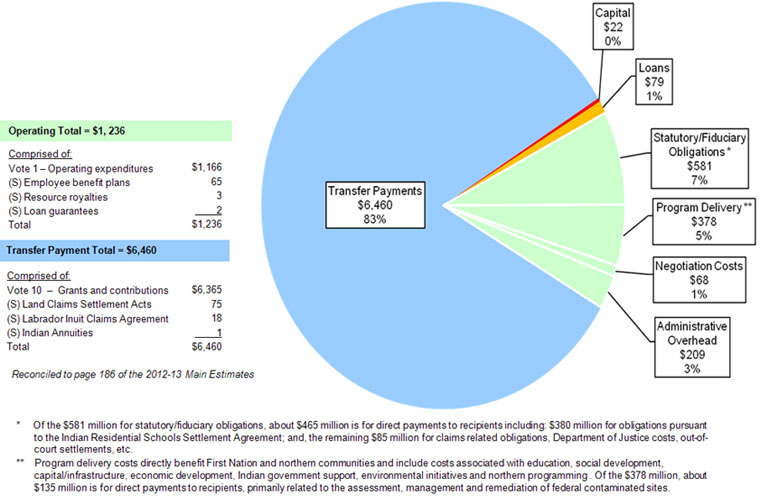Archived - Backgrounder - Aboriginal Affairs and Northern Development Canada's Financial Picture (2012-2013)
Archived information
This Web page has been archived on the Web. Archived information is provided for reference, research or record keeping purposes. It is not subject to the Government of Canada Web Standards and has not been altered or updated since it was archived. Please contact us to request a format other than those available.
Aboriginal Affairs and Northern Development Canada (AANDC) is one of numerous federal departments and agencies that deliver programs and services to First Nations, Inuit, Métis and people living in Canada's North. These programs play an important role in building strong, viable communities and improving the quality of life for Aboriginal people and Northerners.
AANDC is responsible for the majority of federal programs and services that support Aboriginal people and Northerners. According to the 2012-2013 Main Estimates , tabled in Parliament on February 28, 2012, AANDC will spend approximately $7.8 billion (see chart below). Of this, approximately 83 per cent goes directly to recipients through transfer payments. Much of this funding ensures that Aboriginal people have access to basic services comparable to those provided to other Canadians through provincial, municipal and territorial governments. These services include education, housing, community infrastructure (water and sewage systems), social support services and other benefits. In addition to expenditures for basic services, the department promotes economic development, negotiates and oversees the implementation of comprehensive and specific claim settlements, and implements practical forms of self-government.
The cost of basic services is driven by a young and growing Aboriginal population. In fact, the population of Status Indians on reserve has a higher proportion of youth (under 24 years old) than the population of Canada as a whole. This creates a growing demand for basic services with overall population/price increases of three to four per cent per year for the department.
Since 1997-1998, funding for essential programs and services funded by the department for First Nations, have been subject to a two per cent escalator. It should be noted that this does not apply to other AANDC program areas, such as the negotiation and settlement of claims, litigation or Northern Affairs.
Historical Expenditure Profile
Over the period from 2008-2009 to 2012-2013, AANDC's expenditures increased from $7.0 billion to $7.8 billion (in accordance with the 2012-2013 Main Estimates), which represents an average annual increase of about 2.8 per cent. This growth in expenditures reflects increased ongoing demand for essential programs and services. However, other factors have contributed to this increase as well. AANDC has been assigned additional duties in recent years, notably Residential Schools Resolution, which has increased the department's spending. The growth in spending can also be attributed to an increased focus on the settlement of claims as well as to significant investments made in priority areas through successive federal budgets since 2006.
While the department has taken on more responsibilities, its administrative overhead has remained relatively stable at about three to four per cent of its budget.
Capitalizing on Efficiencies
The department is taking steps to operate more efficiently and better execute its mandate. For example, AANDC is actively investing in sectoral tripartite agreements, particularly in the areas of education and child and family services. These agreements allow the department to draw on provincial government expertise, while building greater understanding of the unique needs and circumstances of a diverse Aboriginal population. The department is also relieving the reporting burden of First Nations communities by implementing the new federal Policy on Transfer Payments. It has also introduced a new Default Prevention and Management Policy to provide a range of support and tools to communities.
Getting Results
As AANDC moves forward, it will continue to take a more targeted approach to expenditures for Aboriginal people and Northerners, by focusing on structural reforms and increasing the effectiveness of long-term investments. In trying to find practical solutions to real issues, work will continue with willing partners to renovate programs and develop innovative approaches in the areas of market-based housing, education partnerships and economic development. Maximizing the value of our investments in these areas will have a significant and positive impact on improving the quality of life for Aboriginal people and Northerners.
2012–13 Main Estimates – Total $7,797 million (millions of dollars)

Description of figure: 2012–13 Main Estimates Chart
This image is of a pie chart showing the breakdown of departmental expenditures for 2012-13. The breakdown is shown as follows: $6,460 million (83%) transfer payments; $79 million (1%) loans; $22 million (0%) capital; $581 million (7%) statutory/fiduciary obligations; $378 million (5%) program delivery; $68 million (1%) negotiation costs; $209 million (3%) administrative overhead.
Of the $581 million for statutory/fiduciary obligations, about $465 million is for direct payments to recipients including: $380 million for obligations pursuant to the Indian Residential Schools Settlement Agreement; and, the remaining $85 million for claims related obligations, Department of Justice costs, out-of-court settlements, etc.
Program delivery costs directly benefit First Nation and northern communities and include costs associated with education, social development, capital/ infrastructure, economic development, Indian government support, environmental initiatives and northern programming. Of the $378 million, about $135 million is for direct payments to recipients, primarily related to the assessment, management and remediation of federal contaminated sites.
This image also contains two tables; the first demonstrates the breakdown of forecasted operating expenses – which total $1,236 million – as follows: $1,166 million for operating expenditures; $65 million for employee benefit plans; $3 million for resource royalties and $2 million for loan guarantees. The second table demonstrates the breakdown of transfer payments – which total $6,460 million – as follows: $6,365 million for grants and contributions; $75 million for land claims settlement acts, $18 million for the Labrador Inuit Claims Agreement and $1 million for Indian annuities.
The source for the information for the chart is the 2012-13 Main Estimates. Figures may not add due to rounding.
Figures may not add due to rounding.
The information presented in this backgrounder does not reflect Budget 2012 announcements.